

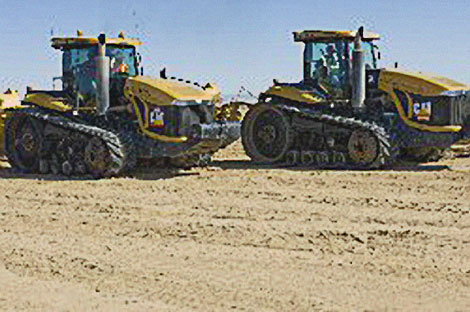 Groundbreaking Event - October 2008 - On October 21, 2008, five large earthmovers broke ground on the Drop 2 Reservoir project. The Secretary of the Department of the Interior, Commissioner of the Bureau of Reclamation, and leaders from the Southern Nevada Water Authority, Central Arizona Project and The Metropolitan Water District of Southern California (accompanied by trained equipment operators from the Ames-Coffman Joint Venture construction partnership) operated the equipment in moving the first loads of earth from the reservoir site. This was the first of the 7 million cubic yards of soil that is being excavated to complete the project.
Groundbreaking Event - October 2008 - On October 21, 2008, five large earthmovers broke ground on the Drop 2 Reservoir project. The Secretary of the Department of the Interior, Commissioner of the Bureau of Reclamation, and leaders from the Southern Nevada Water Authority, Central Arizona Project and The Metropolitan Water District of Southern California (accompanied by trained equipment operators from the Ames-Coffman Joint Venture construction partnership) operated the equipment in moving the first loads of earth from the reservoir site. This was the first of the 7 million cubic yards of soil that is being excavated to complete the project. New Reclamation Reservoir to Provide Additional Water Storage for the Southwest
An innovative, cooperative water conservation project, authorized in 2006 by Public Law 109-432, is taking shape in the Southern California desert just north of the Mexican border. Constructed by the Bureau of Reclamation and funded by partners from three states, the project – known as the Drop 2 Storage Reservoir – will save, on average, 23 billion gallons of Colorado River water per year.
The project's name refers to the reservoir's location just north of the All-American Canal's Drop Structure Number 2, about 30 miles east of El Centro, California. A "drop structure" is a point where water drops from one canal section into another at a lower elevation.
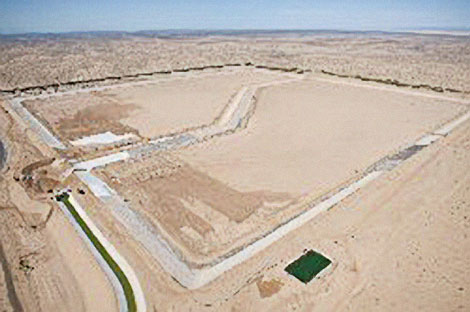 Construction work is nearly complete, with the major components of the project expected to be completed in April. The photos in this gallery portray the small remainder of geomembrane installation left to be completed on the sides and bottom of the reservoir, the completed inlet/outlet structures that will move water to and from the reservoir, and the outlet works constructed under Interstate 8 that will carry water from the reservoir to the All-American Canal. The turnout structure and canal inlet near the Coachella Canal is completed, as well as the 6.5-mile long canal that will deliver water to the reservoir. Aerial photos of the site show the project very near completion.
Construction work is nearly complete, with the major components of the project expected to be completed in April. The photos in this gallery portray the small remainder of geomembrane installation left to be completed on the sides and bottom of the reservoir, the completed inlet/outlet structures that will move water to and from the reservoir, and the outlet works constructed under Interstate 8 that will carry water from the reservoir to the All-American Canal. The turnout structure and canal inlet near the Coachella Canal is completed, as well as the 6.5-mile long canal that will deliver water to the reservoir. Aerial photos of the site show the project very near completion.The reservoir will capture river water that has been released from Parker Dam near Lake Havasu City, Arizona, to meet downstream water orders that have been suddenly cancelled for a variety of reasons. For example, a farm that is heavily rained on may cancel or reduce its order of Colorado River water, or a city could reduce its request because of unexpected canal maintenance. But since the water takes up to 3 days to reach its destination after it's released from Parker Dam, the cancellation requests may have come too late to hold the water in Lake Havasu. And since there are limited places to store this non-usable water downstream of the dam, it usually flows to Mexico.
The United States is required by an international treaty to supply 1.5 million acre-feet (about 500 billion gallons) of Colorado River water to Mexico each year. But the extra water that flows into Mexico from cancelled water orders is not credited toward this requirement. So the United States is building the Drop 2 Storage Reservoir to help the American Southwest more efficiently use its precious – and limited – Colorado River resources.
How It Will Work
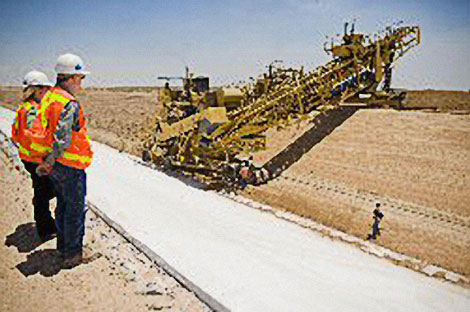 Construction Activities - June 2009 - Activities continue at a rapid pace - at this point, the construction work is nearly 55% complete. The photos in this gallery portray ongoing work on the canal inlet structure near Drop 1 of the All-American Canal, the concrete lining of the canal that will deliver water to the reservoir, and installation of geomembrane lining on the bottom of the excavated reservoir. The massive reservoir inlet/outlet structures have also taken form, rising like concrete monuments from the desert floor near Interstate 8.
Construction Activities - June 2009 - Activities continue at a rapid pace - at this point, the construction work is nearly 55% complete. The photos in this gallery portray ongoing work on the canal inlet structure near Drop 1 of the All-American Canal, the concrete lining of the canal that will deliver water to the reservoir, and installation of geomembrane lining on the bottom of the excavated reservoir. The massive reservoir inlet/outlet structures have also taken form, rising like concrete monuments from the desert floor near Interstate 8.The operational concept of the project is fairly simple: When a water order is canceled or reduced, the "non-storable" Colorado River flows are diverted into the All-American Canal at Imperial Diversion Dam. About 25 miles southwest of Imperial Dam, the water is diverted from the All-American Canal through a turnout structure into a six and a half-mile-long concrete inlet canal capable of filling the reservoir in 72 hours. The water remains stored in the reservoir until needed, usually only about 2 -3 days. Then, the Imperial Irrigation District – which will operate and maintain the facility – drains the water from the reservoir through a quarter-mile-long canal/siphon system back into the All-American Canal for delivery to Imperial Valley lands.
Because Imperial Irrigation District will be able to take some of its Colorado River water supplies from this source instead of Lake Mead, this project will also help maintain Lake Mead water levels. The elevation of the lake is the primary factor in determining whether Colorado River water deliveries are to be reduced for California, Nevada and Arizona in a given year. That's one of the reasons why partners from these 3 states came together to fund the $172 million project. The reservoir will help reduce the effects of drought on the water supplies of these states. So the Southern Nevada Water Authority is contributing $115 million, while The Metropolitan Water District of Southern California and Central Arizona Project are each providing $28.6 million. In return, they receive water from Lake Mead – 400,000 acre-feet for SNWA, and 100,000 acre-feet each for Metropolitan and the CAP over a specified number of years.
Construction 24/7
Following a groundbreaking ceremony in October 2008 construction activities at the site have progressed nearly non-stop. Skilled crews from the Ames-Coffman Joint Venture and experienced Reclamation engineers and inspectors are working in concert day and night through two 10-hour shifts to meet the ambitious deadline for project completion. The reservoir is scheduled to be completed by May 2010, but the developers are attempting to finish by January or February.
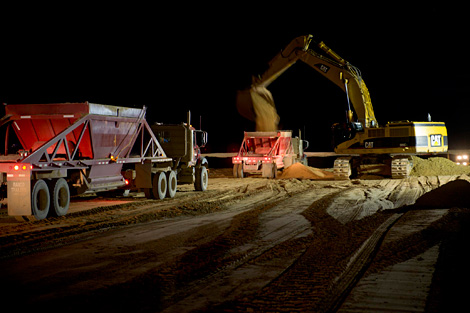 Construction Activities - February 2009 - Skilled crews from the Ames-Coffman Joint Venture and Bureau of Reclamation engineers and inspectors are working in concert day and night through two 10-hour shifts to meet the ambitious 2010 deadline for project completion.
Construction Activities - February 2009 - Skilled crews from the Ames-Coffman Joint Venture and Bureau of Reclamation engineers and inspectors are working in concert day and night through two 10-hour shifts to meet the ambitious 2010 deadline for project completion.Already, the first section of the bifurcation structure has been built at the Coachella Canal turnout. When completed, this feature will divert water from the All-American Canal to Coachella Valley lands and the Drop 2 Reservoir.
Each day, 50 to 60 pieces of massive equipment dash about, re-contouring the previously flat landscape, moving approximately 30,000 to 40,000 cubic yards of earth for the project. (In comparison, the bed of a full-size pickup truck can only hold approximately 2 cubic yards.) Approximately 7 million cubic yards are expected to be moved over the next year – or enough to fill 700,000 dump trucks.
More than 1,700 immense rolls of geomembrane lining – each weighing more than a ton – have been delivered to the site, standing by for installation in the excavated reservoir area. This product will cover the bottom and sides of the reservoir to help prevent the stored water from seeping into the desert floor. In fact, the total square footage of this project's lining can cover nearly 330 football fields!
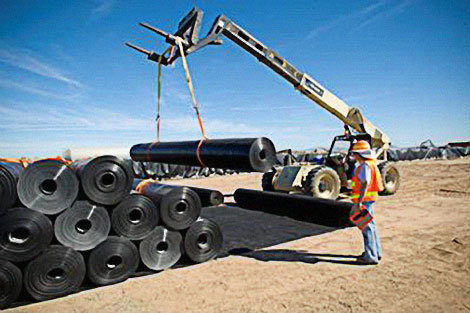 1,700 rolls of geomembrane lining, each weighing more than a ton, stand by for installation in the excavated reservoir area.
1,700 rolls of geomembrane lining, each weighing more than a ton, stand by for installation in the excavated reservoir area.Excavation and concrete placement for the inlet/outlet structures are proceeding, and in June, work begins on the portion of the structures that will run under Interstate 8. For this element, a new section of highway will be constructed to detour traffic around the worksite.
And throughout all this activity, the administration of the project is a constant challenge. Balancing the resource demands and task goals of an undertaking of this scope requires relentless attention, and Reclamation Project Managers Mike Vandevelde and David Palumbo are the supervisors at the forefront of these responsibilities. They serve as leaders, administrators, facilitators, mediators, liaisons, and coordinators for the project team, ensuring the many milestones for the undertaking are executed on time and within budget.
A Solution for Water Challenges
When completed, the project will bring greater reliability to the Southwestern states that share the Colorado River. But more importantly, it serves as an innovative example of the cooperation necessary to solve today's resource challenges.
The Drop 2 Reservoir Storage Project demonstrates that different entities with different needs can work together to share water, and it is very likely to attract attention from other states – even nations – that are facing water challenges.
September 2010:
Secretary of the Interior Ken Salazar approved an Imperial Irrigation District (IID) request to name the new storage reservoir located adjacent to the All-American Canal (AAC) in Southern California the "Warren H. Brock Reservoir."
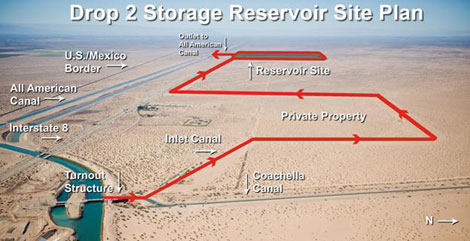 Drop 2 Storage Reservoir site plan.
Drop 2 Storage Reservoir site plan.Mr. Brock was "a prominent, innovative Imperial Valley farmer who participated in numerous commercial ventures as well as experimental farming with different varieties of crops and arid and semi-arid farming methods." Much of this research was conducted at the Brock Ranch Experimental Research Station, a 621-acre site Mr. Brock and his son had leased from Reclamation since the 1950's. This site was chosen for the new reservoir because, of the 45 alternatives studied for potentially capturing and managing these non-storable flows, it provided the greatest opportunity.
The Southern Nevada Water Authority, The Metropolitan Water District of Southern California, and the Central Arizona Water Conservation District, who funded construction of the $172 million project, also supported the name change, in conjunction with IID, the Colorado River Board of California, and other public officials. The Bureau of Reclamation designed and constructed the project.
Sources:
http://www.usbr.gov/lc/region/programs/drop2reservoir.html
http://www.usbr.gov/newsroom/newsrelease/detail.cfm?RecordID=33743
For More Information:
http://www.usbr.gov/lc/yuma/environmental_docs/environ_docs.html
